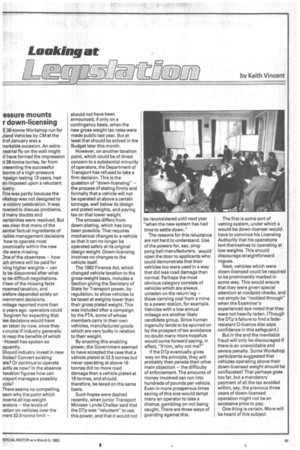. essure mounts r down-licensing
Page 67

If you've noticed an error in this article please click here to report it so we can fix it.
E 38-tonne Workshop run for fland Vehicles by CMat the of January was a
narkable occasion. An extrarestrial fly on the wall might II have formed the impression it 38-tonne lorries, far from ,resenting the successful tcome of a high-pressure npaign lasting 13 years, had en imposed upon a reluctant lustry.
ihis was partly because the orkshop was not designed to a victory celebration. It was evened to discuss problems, d many doubts and certainties were resolved. But vas clear that many of the 3ential factual ingredients of risible management decisions how to operate most Dnomically within the new iits were missing.
Dne of the absentees — how ich drivers will be paid for ving higher weights — can ly be discovered after what ly be difficult negotiations. I two of the missing facts ncerned taxation, and
3refore depended solely on wernment decisions.
mitage reported more than o years ago: operators could forgiven for expecting that ase decisions would have en taken by now, since they a crucial if industry generally to reap the benefits of which ^ Howell has spoken so )quently.
Should industry invest in new hides? Convert existing ets? Or continue to operate actly as now? In the absence taxation figures how can insport managers possibly cide?
There seems no compelling 9son why the point which ncerns all top-weight
erators — the levels of cation on vehicles over the rrent 32.5-tonne limit — should not have been announced, if only on a contingency basis, when the new gross weight tax rates were made public last year. But at least that should be solved in the Budget later this month.
However, on another taxation point, which could be of direct concern to a substantial minority of operators, the Department of Transport has refused to take a firm decision. This is the question of "down-licensing" — the process of stating firmly and formally that a vehicle will not be operated at above a certain tonnage, well below its design and plated weights, and paying tax on that lower weight.
The process differs from down-plating, which has long been possible. That requires mechanical changes to a vehicle so that it can no longer be operated safely at its original design weight. Down-licensing involves no changes to the vehicle itself.
The 1982 Finance Act, which changed vehicle taxation to the gross-weight basis, includes a Section giving the Secretary of State for Transport power, by regulation, to allow vehicles to be taxed at weights lower than their gross plated weight. This was included after a campaign by the FTA, some of whose members carry in their own vehicles, manufactured goods which are very bulky in relation to their weight.
By enacting this enabling power, the Government seemed to have accepted the case that a vehicle plated at 32.5 tonnes but never operating at above 16 tonnes did no more road damage than a vehicle plated at 16 tonnes, and should, therefore, be taxed on the same basis.
Such hopes were dashed recently, when junior Transport Minister Lynda Chalker said that the DTp was "reluctant" to use this power, and that it would not be reconsidered until next year "when the new system has had time to settle down."
The reasons for this reluctance are not hard to understand. Use of the powers for, say, pingpong ball manufacturers, would open the door to applicants who could demonstrate that their vehicles too were used in a way that did less road damage than normal. Perhaps the most obvious category consists of vehicles which are always unladen on the return leg — those carrying coal from a mine to a power station, for example. Vehicles with a low annual mileage are another likely candidate group. Since human ingenuity tends to be spurred on by the prospect of tax avoidance no doubt many more hopefuls would come forward saying, in effect, "If him, why not me?"
If the DTp eventually gives way on the principle, they will probably then parade their other main objection — the difficulty of enforcement. The amounts of money involved can run into hundreds of pounds per vehicle. Even in more prosperous times saving of this size would tempt many an operator to take a chance, gambling on not being caught. There are three ways of guarding against this. The first is some sort of vetting system, under which a would-be down-licenser would have to convince his Licensing Authority that his operations lent themselves to operating at low weights. This should discourage straightforward rogues.
Next, vehicles which were down-licensed could be required to be prominently marked in some way. This would ensure that they were given special attention at roadside checks, and not simply be "nodded through" when the Examiner's experienced eye noted that they were not heavily laden. (Though the DTp's failure to find a faderesistant 0-licence disc saps confidence in this safeguard.) But in the end the inevitable fraud will only be discouraged if there is an unavoidable and severe penalty. Some Workshop participants suggested that vehicles operating above their down-licensed weight should be confiscated! That perhaps goes too far, but a mandatory payment of all the tax avoided within, say, the previous three years of down-licensed operation might not be an excessive price to pay.
One thing is certain. More will be heard of this subject.












































































































